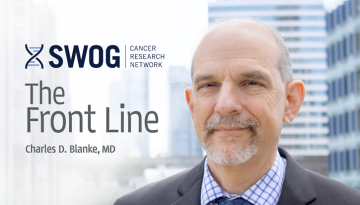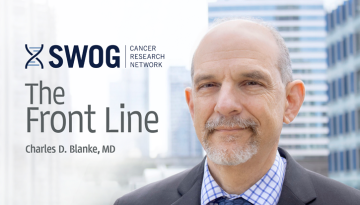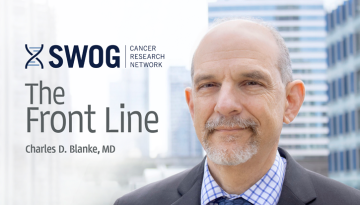Meet the ... SWOG Stat Center
As an NCI National Clinical Trials Network (NCTN) group, SWOG has two core components – our Network Operations Center (NOC) and our Statistics and Data Management Center (SDMC).
The former is responsible for scientific leadership, trial operations, and general administration, while the latter provides statistical expertise for trial design, monitoring, and reporting; leadership in statistical methodology; and data management services and infrastructure.
While many of my columns do report on Stat Center work, explicitly or implicitly, today I want to shine a more direct light on this half of SWOG.
To help ensure SDMC independence, the NCI places a firewall between it and the NOC, supporting the components with separate grants. But though we’re financially separate, SWOG’s NOC and SDMC teams function in sync to achieve our mission of significantly improving lives.
I’m PI on SWOG’s NOC grant, which covers our operations in Portland and San Antonio, and SWOG Group Statistician Mike LeBlanc, PhD, is PI on the SDMC grant, which is based at the Fred Hutchinson Cancer Center. He’s SDMC director as well, in partnership with Cathy Tangen, DrPH, as deputy director.
The SDMC and NOC are also full partners on SWOG’s NCORP research base grant, on which Dr. Tangen and I are co-PIs with Dr. Dawn Hershman.
Clear as mud?
Functionally, the SDMC consists of three cores –
- an administrative core that houses the SDMC’s senior leadership team and works to integrate the statistics and data management components
- a statistics core that leads the statistical design, development, and monitoring of trials and TM studies
- a data management core responsible for delivering high quality, timely trial data and managing the computing resources that make that possible
Administratively, the SDMC is co-located at the Hutch, home to many of our biostatisticians, and at Cancer Research And Biostatistics (CRAB), a nonprofit founded by John Crowley, PhD, (SWOG’s group statistician before Dr. LeBlanc) and led today by Antje Hoering, PhD, CRAB president and CEO.
CRAB is primarily responsible for the information technology infrastructure, applications development, data management, and data capture for SWOG trials. Although it was initially founded to support SWOG’s work and has been an integral part of our SDMC ever since, today CRAB also provides statistical and clinical trial services to other organizations.
Geographically, the CRAB and Hutch SDMC offices are in Seattle – within about a mile of each other, actually, so meeting for an SDMC lunch is not the kind of logistical challenge that, say, meeting for an NOC lunch would be. In fact, after every group meeting, there’s a SWOG SDMC “all-staff” event at the Hutch (Mike tells me the next is fast approaching – November 29th). Given that many staff members can’t attend group meetings in person, the SDMC all-staff is a chance to share group meeting updates, SWOG study results, and reports on new initiatives.
Between the Hutch and CRAB, SWOG’s SDMC comprises more than 100 individuals, at varying levels of effort. For many reading this, the SDMC staff you’re most likely to interact with are probably our data coordinators, who are often the experts on the receiving end of the help email addresses in our protocols.
Of course, the SDMC personnel with the highest name recognition at SWOG are generally our faculty biostatisticians, most of whom provide statistical leadership for one or more of our research committees (in addition to their numerous non-SWOG research projects). They’re typically listed in the second author slot on trial result publications, although you’ll also see them as first authors on results of research projects or data analyses they’ve led. Their effort can be funded by numerous sources in addition to our core grants, including grants from the NIH and other government agencies, and awards from charitable organizations such as The Hope Foundation.
SDMC’s statistical research associates (master’s statisticians) and statistical unit assistants underpin many projects, doing much more than just analysis, with senior SRAs at times taking the lead coordinating and analyzing SWOG trials.
But it’s also true (and I know Mike agrees) that none of our research would happen without the many remarkable SDMC staff who don’t have any form of the term “statistics” in their job title. These include the data management team who interact with staff at our member institutions and the SDMC administrators who manage grants, budgets, meetings, and so much more. Not to mention the applications developers and IT gurus who build and manage our electronic data capture systems and the tools our statisticians use to monitor and analyze data.
And keep in mind that in addition to maintaining data from past trials – and from the roughly 100 SWOG studies now in follow-up and still tracking patients – SDMC staff also adhere to a growing complex of data reporting and sharing policies from clinicaltrials.gov, the NIH, and other agencies.
SWOG’s overall excellence as a cancer research organization is, to a huge extent, dependent on the quality of our SDMC. Happily, this quality is second to none, and we have the numbers to prove it! I’ve said this before, but it bears repeating – during our most recent grant renewal, the reviewers’ score of the SWOG SDMC’s application was, I believe, the best score awarded to any component of any NCTN group during that renewal cycle.
___________________________________________________
Trial of the Week
S2206: Phase III Trial of Neoadjuvant Durvalumab (NSC 778709) plus Chemotherapy versus Chemotherapy Alone for MammaPrint Ultrahigh (MP2) Hormone Receptor (HR) Positive / Human Epidermal Growth Factor Receptor (HER2) Negative Stage II-III Breast Cancer
S2206 is quite literally our “trial of the week.” It activated on Monday.
Results of I-SPY2 and other studies suggest that for patients with HR+, HER2- early-stage breast cancer who are considered to be at very high risk of recurrence, adding an immune checkpoint inhibitor to the neoadjuvant chemotherapy commonly given to these patients can provide an added benefit.
S2206 will test this hypothesis, randomizing these high-risk patients to neoadjuvant chemo with or without durvalumab.
Patients on S2206 will be classified as being at very high risk of recurrence on the basis of a High 2 score on a MammaPrint genomic test. The trial will screen almost 3,700 patients with the MammaPrint test to randomize 960 with a High 2 score. Patients who have previously had a High 2 result on the MammaPrint assay may be enrolled directly to the randomization step.
On trial, the MammaPrint screening test is conducted at no cost to the patient. The cost of durvalumab is also covered.
Importantly, the study includes quality-of-life endpoints comparing change in the level of fatigue and change in global physical health and global mental health across the trial arms, among other measures.
Erin Cobain, MD, of the University of Michigan Rogel Cancer Center is study chair.
Of course, since the trial activated only this week, the running for top-accruing sites is still wide open. I recommend getting in on the action ASAP.
Learn more on the CTSU S2206 page (the SWOG S2206 page will be posted shortly).
Other Recent Stories



